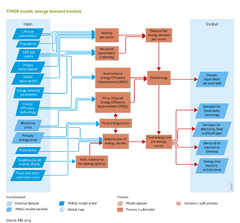Energy demand: Difference between revisions
Jump to navigation
Jump to search
No edit summary |
No edit summary |
||
| Line 17: | Line 17: | ||
# residential; | # residential; | ||
# services (both public and private; | # services (both public and private; | ||
# other (mostly agriculture).<ref | # other (mostly agriculture).<ref >''lala'' </ref> | ||
Within each of these sectors, final energy use is driven by the demand for energy services, such as motor drive, mass displacement, chemical conversions, lighting, heating and cooling. Here, the demand for energy is considered a function of three groups of parameters and processes: | Within each of these sectors, final energy use is driven by the demand for energy services, such as motor drive, mass displacement, chemical conversions, lighting, heating and cooling. Here, the demand for energy is considered a function of three groups of parameters and processes: | ||
#activity data (e.g. on population and income, and more explicit, activity indicators such as steel production); | #activity data (e.g. on population and income, and more explicit, activity indicators such as steel production); | ||
Revision as of 15:29, 12 November 2013
| Component is implemented in: |
|
| Related IMAGE components |
| Projects/Applications |
| Key publications |
Key policy issues
- How will energy demand evolve particularly in emerging and medium- and low-income economies?
- What is the mix of end-use energy carriers to meet future energy demand?
- How can energy efficiency contribute to reducing the growth rate of energy demand and mitigate pressures on the global environment?
Introduction
"model component" is not in the list (driver component, pressure component, interaction component, state component, impact component, response component) of allowed values for the "FrameworkElementType" property.
